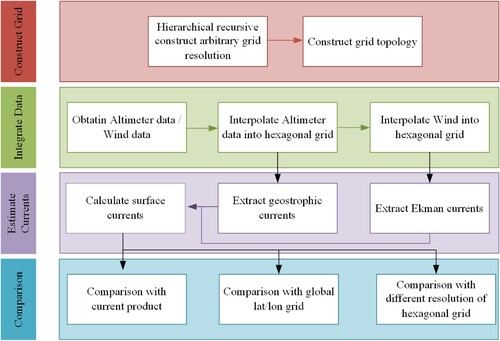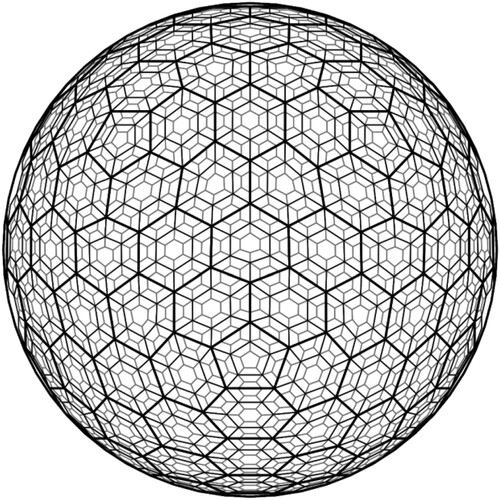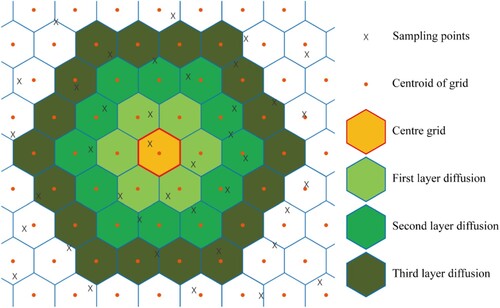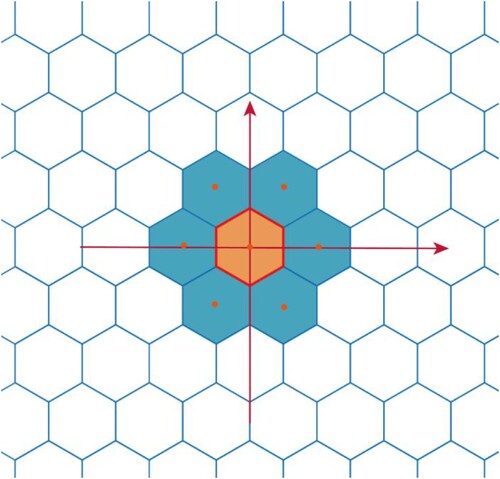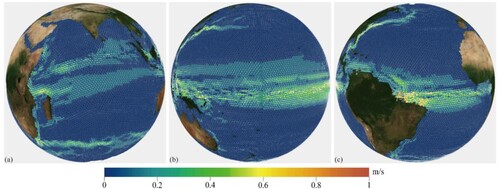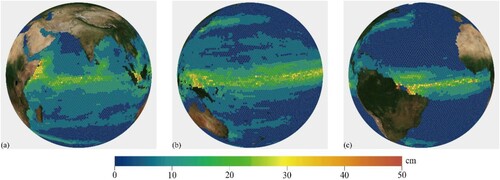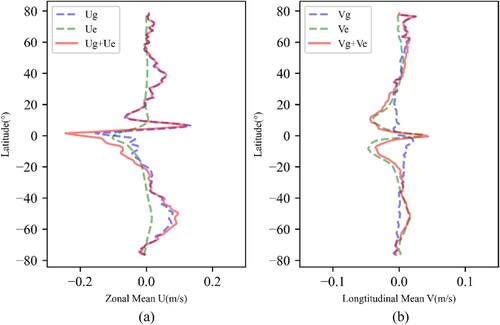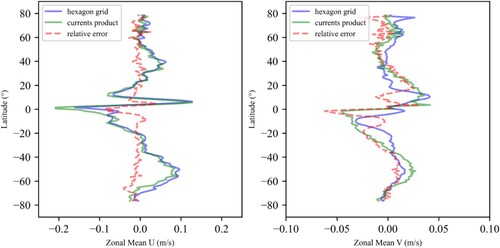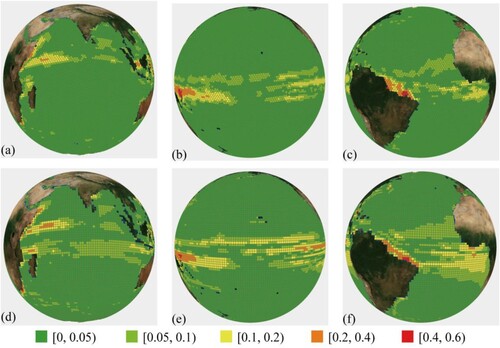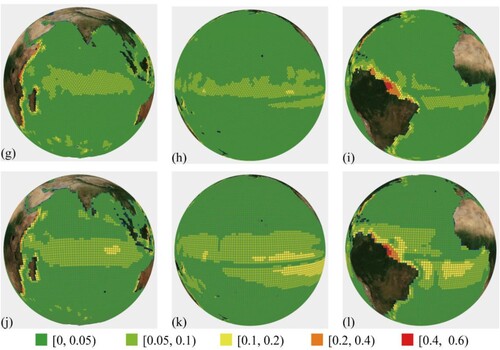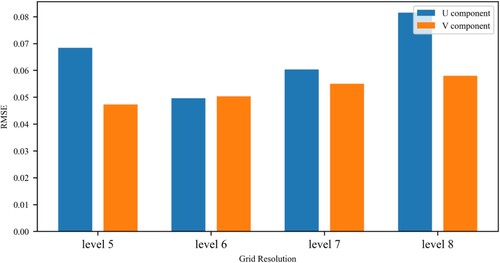 ?Mathematical formulae have been encoded as MathML and are displayed in this HTML version using MathJax in order to improve their display. Uncheck the box to turn MathJax off. This feature requires Javascript. Click on a formula to zoom.
?Mathematical formulae have been encoded as MathML and are displayed in this HTML version using MathJax in order to improve their display. Uncheck the box to turn MathJax off. This feature requires Javascript. Click on a formula to zoom.ABSTRACT
Global ocean surface currents estimated from satellite derived data based on a regular global grid are affected by the grid’s shape and placement. Due to different neighbourhood relationships, the rectangular lat/lon grids lose accuracy when interpolating and fitting elevation data. Hexagonal grids have shown to be advantageous due to their isotropic, uniform neighbourhood. Considering these merits, this paper aims to estimate global ocean surface current using a global isotropic hexagonal grid from satellite remote sensing data. First, gridded satellite altimeter data and wind data with different resolutions are interpolated into the centre of the global isotropic hexagonal grid. Then, geostrophic and Ekman currents components are estimated according to the Lagerlof Ocean currents theory. Finally, the inversion results are verified. By analyzing the results, we conclude that the ocean surface currents estimated based on the global isotropic hexagonal grid have considerable accuracy, with improvement over rectangular lat/lon grids.
1. Introduction
Ocean surface currents are the relatively stable flow of sea water. The transport of heat and freshwater by ocean currents is crucial in a wide range of ocean processes. These processes range from phytoplankton growth (Llido et al. Citation2005) to the animal migration (Poloczanska et al. Citation2016; García Molinos, Burrows, and Poloczanska Citation2017; Girard et al. Citation2006). From the ocean-surface temperature anomaly (Lagerloef et al. Citation2003; Picaut et al. Citation1996) to substance diffusion (Maes et al. Citation2006; Maes, Sudre, and Garçon Citation2010).
Indirect inversion from satellite derived data is an important method to obtain ocean currents information, especially for large ocean areas. Repeated satellite remote sensing of sea level height offers the opportunity to study geostrophic approximation of the ocean (Chelton, Schlax, and Samelson Citation2011). Combined with wind fields, also observed from satellite altimeter, ocean surface currents can be estimated by a steady balance between geostrophic and Ekman dynamics (Lagerloef et al. Citation1999).
Satellite remote sensing data are commonly organized as either trajectory data or onto rectangular lat/lon grids. The former needs to use the crossover analysis method (Tai Citation1988) or the collinear trajectory analysis method (Van Gysen et al. Citation1992) to correct satellite trajectory error. For the global ocean area, the crossover analysis method will cause a large amount of non-crossover data to not be used. Meanwhile, the collinear trajectory analysis method will cause a large amount of data redundancy.
Many researchers estimated ocean surface currents from gridded satellite remote sensing data. Some scholars used the integrated remote sensing data from multiple satellites and wind data of QuikSCAT to retrieve global ocean surface currents (Liu et al. Citation2012; Sudre, Maes, and Garçon Citation2013; Sudre and Morrow Citation2008; An et al. Citation2012). Lagerloef et al. (Citation1999) analysed tropical pacific near-surface currents from TOPEX/Poseidon altimeter data and Special Sensor Microwave Imager (SSMI) wind data. Because the spatial-temporal resolutions of altimeter data and wind data differ, spatial-temporal interpolations are often needed prior to inversions.
Traditional rectangular grids have two different neighbourhood relations: orthogonal neighbours and diagonal neighbours. The different neighbourhood relationships lead to multiple distance calculation methods and less uniform sampling points. Whereas the distance for orthogonal neighbours will be units of length, the distance for diagonal neighbours will be units of length. Tang, Zhao, and Cao (Citation2000) also concluded that the diagonal neighbourhoods have lower accuracy in topographic data processing due to their greater distance. Huang (Citation2018) found the distribution of control points determines the accuracy of the quadric surface elevation fitting model when given the same number of control points. Specifically, the more uniform the distribution of control points, the higher the accuracy of the fitting model. Given the greater distance and decreased uniformity, rectangular grids may not be the best regular grid for structuring satellite data.
In many fields, the hexagonal grids have several advantages over the traditional lat/lon grids due to their compact structure, isotropic neighbourhood and consistent connectivity (Middleton and Sivaswamy Citation2005; White and Kiester Citation2008; Lai et al. Citation2016; Yu et al. Citation2015; Tong et al. Citation2013; Mahdavi-Amiri, Harrison, and Samavati Citation2015; Kimerling et al. Citation1999; Wang et al. Citation2020; Liao et al. Citation2020). In the hexagonal structure, each cell shares an edge with six neighbour cells, which greatly simplifies the neighbour relationship. The centroids of adjacent cells are all at the same distance, meaning that the hexagon has a consistent connectivity. Thus, hexagonal grids are more suitable for neighbourhood processes, used to solve problems related to nearest neighbour domains, mobility, or connectivity (Birch, Oom, and Beecham Citation2007; Wang and Kwan Citation2018). Nevertheless, due to the complex composition and construction of a hexagonal grid, most ocean datasets are not aggregated to hexagonal structures. It is not widely used in ocean satellite remote sensing data analysis.
At global scales, lat/lon grids cause problems, such as spatial distortions (Liao et al. Citation2020), fracture and inconsistency of spatial relationship, and data overlap. These problems make traditional lat/lon grids unsuitable for global analyses (Baumann Citation2021; Kmoch et al. Citation2022; Rawson, Sabeur, and Brito Citation2022; Han et al. Citation2022). Discrete global grid systems are designed specifically for data integration and information retrieval (Thompson et al. Citation2022; Hojati et al. Citation2022; Wang et al. Citation2022). This paper applies a global surface flow extraction algorithm using a spherical hexagonal discrete global grid as the data framework.
The remaining sections of this paper are arranged as follows. In section 2, we provide an overview of our methods, including the grid characteristics and the ocean surface flow extraction algorithm. In section 3, we apply the algorithm across a global hexagonal grid based on nine years’ monthly average ocean satellite data and analyze the results. In section 4, we compare the results against results using traditional lat/lon grids. In sections 5 and 6, we discuss and summarize the findings of this study.
2. Methods
2.1. Overview
To resolve the different neighbourhood relationships issue inherent to traditional lat/lon grids, we propose an ocean currents extraction method based on a hexagonal grid system. We developed a list of traditional ocean current extraction algorithms as candidates to consider for our hexagonal grid method.
The Lagerloef et al. (Citation1999) ocean currents theory assumes that geostrophic and Ekman components accounting for the lower-order dynamics of surface velocity could be obtained independently from surface height and wind stress data. The resulting algorithm is a statistical model where geostrophic varied smoothly from a β plane formulation at the equator to an f plane formulation in the mid-latitude and the two-parameter Ekman model. This algorithm is relatively well-considered in ocean currents theory, so this study uses the ocean currents algorithm proposed by Lagerloef to extract global ocean surface currents.
Four main steps were taken, constructing the grid, integrating data onto the grid, estimating currents using the Lagerloef ocean current algorithm, and comparison of results, as shown in . Gridded satellite altimeter data and wind data of different resolutions were interpolated and then aggregated to the hexagonal grid based on grid cell centre. These data were used to extract both geostrophic and Ekman components for surface currents. Results were compared to three experiments.
2.2. Construct spherical hexagonal discrete grids
The first characteristic of a grid system is what base solid it uses to represent the spheroid. Global hexagonal grids are mainly based on either an octahedron (Bai Citation2011) or icosahedron (Zhang et al. Citation2006; Bai, Zhao, and Chen Citation2005). We chose the icosahedron as these grids have less distortion and more uniform geometric properties.
The second characteristic of a hexagonal grid is the system used to create hierarchical recursive subdivisions. In this paper, we use Icosahedral Snyder Equal Area (ISEA) projection and pole orientation to generate a geodesic grid system (Sahr Citation2011). Using aperture 4 for subdivisions; that is, the area of any upper level of grid cells is four times that of the next lower level. shows levels 5 through 8 of our grid generated by DGGRID (Sahr Citation2015). provides the number of cells and comparable coordinate based resolutions for these four levels. However, we cannot use array indices directly unless a dedicated hexagon grid index system is available (Sahr Citation2019). Therefore, we use half-edge structure to construct the grid geometric topology (Mcguire Citation2000).
Table 1. Resolution information of the hexagonal grid.
2.3. Integrate satellite remote sensing data on a spherical hexagonal grid
Data types from remote sensing sources included discrete points, Triangular Irregular Networks (TIN), and raster grid data. Values from TIN / rectangular grids are regarded as discrete values and are treated as discrete points at the grid centre when attributing them to the hexagonal grid. Then, the integrate method based on these sampling points can be achieved to build a hexagonal grid-based TIN/ rectangular data. The detailed procedure is as follows:
Select the appropriate grid resolution based on the resolution of the satellite altimeter data.
Assign terrestrial cells in the satellite altimeter data to None.
Use nearest neighbour interpolation to aggregate data points to hexagonal grid cell centres.
For any hexagonal cell without an assigned value, search neighbours in recursive bands until at least four with valid values are identified (). The cell value is estimated from the identified neighbours using the inverse distance weighted interpolation method according to the spherical distance formula (Equation 1).
(1)
(1)
2.4. Extract geostrophic and Ekman components
We use spherical hexagonal grid satellite altimeter data and wind data to retrieve global ocean surface currents. According to Lagerloef et al. (Citation1999), the ocean surface currents are the sum of the geostrophic component and Ekman component at 15 m depth, as shown in Equation (2).
(2)
(2) where U are the surface currents, Ug (
,
) is the geostrophic component, and Ue (
,
) is the Ekman component.
2.4.1. Surface geostrophic currents
The geostrophic currents are calculated from the Absolute Dynamic Topography (ADT), which is the sum of Maps Sea Level Anomaly (MSLA) and Mean Dynamic Topographic (MDT). Therefore, ADT is the absolute dynamic topography relative to the geoid. The geostrophic balance assumes that momentum advection and frictional forces are slight. Outside the equatorial band, geostrophic velocities are given by
(3a)
(3a) and
(3b)
(3b) where y and x are the positions, f is the Coriolis parameter, g is the acceleration due to gravity, and h is the ADT.
Within the equatorial band, where latitude is equal to zero, the geostrophic equilibrium relationship is no longer applicable, and equatorial theory suggests using the second derivative of surface height on an equatorial β-plane. The equations for each component of the current () on the β plane are
(4a)
(4a) and
(4b)
(4b) where β = 2.3 *
. Using weighting function (equation 5a and 5b) within the equatorial band to ensure the continuity of geostrophic current from the β-plane calculation in the equatorial band to the outside. Outside of this band, the estimate of the currents is still purely geostrophic.
(5a)
(5a)
(5b)
(5b)
and
is determined by Equation 6, where θS = 2.2°, C is a weighting factor. Based on the actual velocity of the currents velocity in the equatorial region, and C is set to 0.7.
(6a)
(6a) and
(6b)
(6b)
When calculating the first and second derivatives under a spherical hexagonal grid, it is necessary to orient the origin of the rectangular grid’s local plane coordinate system to the centre point of the hexagonal grid, as shown in . The values attributed to the centre point and its surrounding six grid cells were taken as input. The first and second partial derivatives of the centre point were calculated using the bivariate quadric surface fitting, using Equation 1 to calculate the distance between centre points.
2.4.2. Surface Ekman currents
The ocean surface wind stress is the main driving force for generating Ekman currents. Thus, the ocean surface wind stress should be calculated to obtain the velocity of Ekman currents. Wind stress is a force on the ocean’s surface caused by the viscous effect of the molecules between the two layers of fluid when the wind-driven airflow moves relative to the ocean currents. The block calculation equation of the wind stress vector is:
(7)
(7) where (τx, τy) is the wind stress field, ρa = 1.2 kg/
is the air density, V10 is the wind speed value at 10 m above the ocean surface, (u10, v10) is the wind speed value, and
is swaying coefficient. The scheme of
is as follows:
(8)
(8)
For different latitudes, two sets of parameter models are used to calculate the Ekman currents:
Within 25°S ∼ 25°N, using Equation (9).
(9)
(9) where ρ = 1.02 *
kg/
is water density, r = 2.15×10−4m/s is friction coefficient, hmd = 32.5 m is mixed layer depth, f is Coriolis parameter (f = 2Ωsinφ, Ω is angular velocity of the earth’s rotation, φ is latitude), and ue and ve are the east and north components of the Ekman currents, respectively.
Outside 25°S ∼ 25°N
B and θ are constants, B = 0.3ms-1Pa-1, θ is the turning angle relative to the wind direction, 55° to the right of the wind in the northern hemisphere and 55° to the left of the wind in the southern hemisphere.
3. Case study
The second section introduced a process to estimate ocean surface currents based on a global hexagonal grid. To evaluate the feasibility of the proposed method, we applied the process to the global ocean and analyzed the results.
3.1. Data sources
Based on the global hexagonal grid and the above method, we estimated monthly mean global ocean surface currents from satellite remote sensing data.
3.1.1. Sea surface height
The mapped Absolute Dynamic Topographic (ADT) data were processed by Data Unification and Altimeter Combination System (DUACS) and distributed by AVISO. The ADT product for the 1993-ongoing period merges altimeter measurements from five altimeter missions (Topex/Poseidon, ESR1&2, Geosat, Envisat, Jason-1). The complete DUACS process is details in (Pujol et al. Citation2016; Taburet et al. Citation2019).
3.1.2. Wind stress
The mapped monthly global wind data are averaged from daily wind fields calculated from retrievals derived from Advanced SCATterometer (ASCAT) onboard METOP-A and METOP-B satellites and distributed by Copernicus Marine Service (CMEMS). The resulting daily wind fields are estimated as equivalent neutral-stability 10 m winds. The product provides monthly mean stress-equivalent wind and stress variables as well as their standard deviation. (Copernicus Citation2022b).
3.1.3. Satellite currents products
We used the Global Ocean Ensemble Reanalysis data distributed by CMEMS (Copernicus Citation2022a) to evaluate our monthly average ocean surface currents. The ensemble comprises four reanalysis products covering the ‘altimeteric era’ period from January 1st, 1993 onward. Variables include mean temperature, salinity, currents, and ice at 1-degree horizontal resolution for 75 vertical levels.
3.1.4. Regeneration of ocean data
We used a level 6 hexagonal grid for global ocean surface currents as this level best approximates the 1° × 1° minimum resolution of source data and the lat/lon grid (). Then, we used the method introduced in section 2.3 to integrate the ocean data into the hexagonal grid and the lat/lon grid, respectively ().
Table 2. Integrated ocean data.
3.1.5. Gauge stations
There are a total of 102 tidal gauge stations, including 22 stations in the North Atlantic, 19 stations in the South Atlantic, 18 stations in the Indian Ocean, 26 stations in the North Pacific, and 17 stations in the South Pacific. The stations are well distributed as shown in , allowing for regional verification of our estimates. Most of these tidal gauge stations use deep-sea bottom instruments, which Shum et al. (Citation1997) used to evaluate the accuracy of dozens of global ocean models.
3.2. Results
3.2.1. Average ocean surface currents
Average monthly global surface currents from January 2010 to December 2019 were estimated based on satellite-derived data and the above methods. Several important global ocean circulation features can be identified in :
The South (North) Equatorial Currents from east to west between 10°∼20°S (N), and the Equatorial Counter Currents flowing from west to east near the equator.
The Somali Currents in Indian Ocean region of the sub-plot (a).
The Kuroshio current flowing northward at the western border of the Pacific Ocean in the sub-plot (b).
The Gulf Stream flowing northward at 40°N latitude in the Atlantic Ocean in sub-plot (c).
These large-scale features are consistent with both observed ocean currents and previous studies.
3.2.2. The standard deviation of the ocean surface currents
The standard deviation for the global ocean surface currents were computed from January 2010 to December 2019 (). Large current variability is evident within the strong boundary currents. Throughout the equator, the standard deviation is generally above 40 cm/s, indicating that the equatorial current system is very active. In the Indian Ocean ((a)), the most significant variation is in Somalia, where the famous Somali currents change direction with the seasons (to the south in winter and to the north in summer). This is more prominent than the Kuroshio current in the Pacific Ocean ((b)), whose standard deviation over the 9 years is 35∼40 cm/s. In the Atlantic ((c)), warm currents cause the Gulf of Mexico to be very active.
3.2.3. Zonal mean ocean surface currents
Through 9 years of inversion, the estimated zonal velocity U and meridional velocity V of the surface currents were averaged in the zonal directions, respectively, and their changes with latitude were given. In , sub-plot (a) is the zonal profile of the zonal velocity U, where the blue dashed line represents geostrophic zonal velocity, the green dashed line represents Ekman zonal velocity, and the solid red line represents the zonal surface velocity. For the zonal velocity, the geostrophic flow caused by pressure gradient is dominant, especially in the middle and high latitudes, where the Ekman flow is much weaker than the geostrophic flow. Sub-plot (b) of shows the zonal profile of meridional velocity V. These figures suggest the Ekman flow caused by wind stress is dominant for meridional velocity, and the geotropic meridional flow is much weaker than the Ekman flow. Therefore, the structure of ocean flow estimated by satellite remote sensing inversion obtained in conforms to the basic law of earth fluid motion.
4. Comparisons
To verify the accuracy of ocean surface currents extracted to a global hexagonal grid, we carried out a three part experimental verification. First, we evaluated the hexagon grid-based results against the observational datasets. Second, we compared the hexagon grid-based and lat/lon grid-based results. Finally, the extraction accuracy of several different resolution grids was compared.
4.1. Comparison with current product
Several satellite near-surface current products exist and are distributed over various platforms. We selected validation data with the same resolutions as our resulting data (see section 3.1.3 for details). The U and V components of the ocean surface currents obtained by the model algorithm and those of the validated ocean currents data were averaged along the latitude for nine years. shows the relative U/V component error compared to the currents product. The blue line represents the calculation results under the hexagonal grid, the green line represents the currents product, and the red dashed line represents the relative error between them (unit: m/s). The U component had small overall error, with the largest error (0.1 m/s) near the equator. The V component similarly had the largest error near the equator, around 25 degrees north and south latitude.
4.2. Comparison with global lat/lon grid
This paper verifies the advantages of the hexagonal discrete grid in extracting surface currents from satellite remote sensing data by comparing the results of global surface currents with those of lat/lon grids. We use the same model and same level 6 approximate resolution (See ) to extract the global surface ocean surface currents based on the global hexagonal grid and the global lat/lon grid, respectively.
and compare the Absolute Errors (AE) in U and V components between the two types of grids to the validation data based on the mean value of 9 years’ monthly mean flow obtained by inversion. In the Figures, subplot a ∼ c and g ∼ i show AE under the global hexagonal grids, and subplot d ∼ f and j ∼ l show AE under the global lat/lon grids. The error units are m/s.
From the figures, it can be concluded that:
The AE of U/V components are less than 0.05 m/s for both types of grids in ocean areas with gentle velocities.
The error is greater in near-shore areas and where ocean currents are stronger, with a maximum of over 0.4 m/s.
For the U component velocity, the calculation errors based on the global lat/lon grid in the south/north equatorial current and equatorial countercurrent are larger than those under the global hexagonal grid.
For the V component velocity, the calculation error in the global hexagon is mainly distributed in the range of 0.05 ∼ 0.1 m/s. Although the calculation error in the lat/lon grid cells is mainly in the same range, far more cells have 0.1 ∼ 0.2 m/s error.
compares the result accuracy of the two types of grids by quantifying the proportion of grid cell in each category from and . The proportion of hexagonal grid cells in the [0, 0.05] category is about 2% greater than that of the lat/lon grid, for both the U and V components, indicating the hexagonal grid more often calculates currents with errors under 0.05 m/s. Within the error range of [0.05∼0.2], the proportion of hexagonal grid cells in U and V components is 10.18% and 13.32%, respectively, while the proportion of lat/lon grid cells is 13.54% and 15.28%, respectively. Although the proportion of hexagonal grid cells is slightly greater than that of lat/lon grid cells in the [0.2 ∼0.6] error interval, these cells represent less than 1%, a limited proportion. Therefore, it is reasonable to conclude that the hexagonal grid has higher accuracy than the global lat/lon grid when calculating ocean currents from satellite data.
Table 3. Percent of grid cells of each category.
4.3. Comparison of different resolution of hexagonal grids
A global hexagonal grid with level 6 resolution corresponds to a spatial resolution of 1 degree. However, the influence of grid resolution on surface ocean current extraction is also an important part of the experiment. Therefore, we compare the extraction accuracy of several different resolutions of hexagonal grids.
In this section, we evaluated four levels of hexagonal grid (level 5 ∼ level 8, as shown in ) on their ability to estimate monthly mean ocean currents for 2019 compared to gauge stations (). Using the hexagonal grid estimates, we interpolate the value at each tide gauge station for comparison. Error (RMSE) is calculated at 102 points where tide gauge data was available, but five of the points were omitted because they were on small islands. shows the level 6 grid had the smallest overall error (see Appendix 1–2 for specific data).
5. Discussions
5.1. The advantages of an isotropic hexagonal grid
and show the U component flow error is larger than that of the V component flow, likely because mainly geostrophic currents control the U component flow. Calculating geostrophic currents requires interpolating elevation points and calculating first and second-order gradients by surface fitting. As a result, the U component is more error prone and less accurate than the V component.
The same figures show when grid resolution is the same, the error of estimated based on the isotropic hexagon is smaller than that of estimates based on the global lat/lon grid. Huang (Citation2018) concluded that the uniform distribution of control points improves of the accuracy of interpolation results. Therefore, the more uniform distribution of cells in a discrete hexagonal grid improves the accuracy of geostrophic elevation plane interpolation fitting compared to a lat/lon grid.
5.2. The optimal hexagonal grid resolution
With 1°×1° monthly average ocean current product data as comparative data, we compared the extraction accuracy under different grid resolutions in section 4.3. As shown in , the greatest extraction accuracy was achieved for both U and V components when using a level 6 grid. We find that the resolution of the grid affects the accuracy of the extraction results, and it is not that the higher the grid resolution, the higher the accuracy of the extracted currents. This conclusion is in line with the findings of Hodgson (Citation1995) and Kenward et al. (Citation2000) that terrain data quality and resolution significantly affect the accuracy of any extracted hydrological features. Vaze, Teng, and Spencer (Citation2010) concluded that terrain process scale is the key driver in determining useful grid resolution cell.
There are significant differences in extraction results based on high resolution and coarse resolutions of the hexagonal grid. However, as a limitation of this study, we did not study in depth the effect of hexagonal grid cell size on ocean currents information extracted from satellite data. Meanwhile, global lat/lon grids are not true rectangular grids (poles) and grid cells are far from equal area. When comparing with the extraction results of hexagon grid with the same resolution, this will cause some errors in the analysis of the results. Therefore, we will deeply explore this question in future research.
6. Conclusions
Global lat/lon grids have inherent differences in distance measurements across eight directions due to the isotropy, thus inhibiting the extraction of global surface currents to such grids. However, in the tessellation model representing real planar space, the hexagon, as a regular grid, has superior performance due to its consistent connectivity, compact structure, and isotropic local neighbourhood. Therefore, a method of global surface ocean currents based on global hexagonal grid is proposed in this paper. The effectiveness of the proposed method is tested by applying it to 9 years of monthly average ocean satellite remote sensing data. Compared with the method based on global lat/lon grid at the same resolution, the following conclusions can be drawn:
The global hexagonal grid provides a framework for processing global ocean satellite remote sensing data. The extraction results for nine years’ monthly mean ocean flow are consistent with the law of ocean surface currents and compared with the validation data.
Results calculated based on the hexagonal grid compared favourably to those calculated based on a lat/lon grid of the same resolution. based on the greater accuracy relative to validation data it can be concluded that the isotropic grid has advantages over the lat/lon grid when processing satellite data.
This paper demonstrates the important influence of grid geometry on estimates of global surface ocean currents and provides a new approach for the spatial analysis of ocean data.
Data and availability statement
The data that support the findings of this study are available through the following private link: https://doi.org/10.5281/zenodo.7588392.
Disclosure statement
No potential conflict of interest was reported by the author(s).
Additional information
Funding
References
- An, Yuzhu, Ren Zhang, Huizan Wang, Jian Chen, and Weitao Zhang. 2012. “Ocean Surface Currents Retrieval Based on Satellite Remote Sensing Data.” Marine Science Bulletin 31 (1): 1–8. doi:10.3969/j.issn.1001-6392.2012.01.001.
- Bai, Jianjun. 2011. “Location Coding and Indexing Aperture 4 Hexagonal Discrete Global Grid Based on Octahedron.” Journal of Remote Sensing 15 (6): 1125–37. doi:10.11834/jrs.20110367.
- Bai, Jianjun, Xuesheng Zhao, and Jun Chen. 2005. “Indexing of Discrete Global Grids Using Linear Quadtree.” Geomatics and Information Science of Wuhan University 30 (9): 805–8. doi:10.3969/j.issn.1671-8860.2005.09.013.
- Baumann, Peter. 2021. “A General Conceptual Framework for Multi-Dimensional Spatio-Temporal Data Sets.” Environmental Modelling & Software 143: 105096. doi:10.1016/j.envsoft.2021.105096.
- Birch, Colin P. D., Sander P. Oom, and Jonathan A. Beecham. 2007. “Rectangular and Hexagonal Grids Used for Observation, Experiment and Simulation in Ecology.” Ecological Modelling 206 (3-4): 347–59. doi:10.1016/j.ecolmodel.2007.03.041.
- Chelton, Dudley B., Michael G. Schlax, and Roger M. Samelson. 2011. “Global Observations of Nonlinear Mesoscale Eddies.” Progress in Oceanography 91 (2): 167–216. doi:10.1016/j.pocean.2011.01.002
- Copernicus. 2022a. Global Ocean Ensemble Physics Reanalysis – Low Resolution. Copernicus Marine Service. Accessed 9 September 2022. doi:10.48670/moi-00181.
- Copernicus. 2022b. Global Ocean Monthly Mean Sea Surface Wind and Stress from Scatterometer and Model. Copernicus Marine Service. Accessed 12 September 2022. doi:10.48670/moi-00181.
- García Molinos, J., M. T. Burrows, and Elvira S. Poloczanska. 2017. “Ocean Currents Modify the Coupling Between Climate Change and Biogeographical Shifts.” Scientific Reports 7 (1): 1332. doi:10.1038/s41598-017-01309-y.
- Girard, Charlotte, Joël Sudre, Simon Benhamou, David Roos, and Paolo Luschi. 2006. “Homing in Green Turtles Chelonia Mydas: Oceanic Currents Act as a Constraint Rather Than as an Information Source.” Marine Ecology Progress Series 322: 281–9. doi:10.3354/meps322281
- Han, Bing, Tengteng Qu, Zili Huang, Qiangyu Wang, and Xinlong Pan. 2022. “Emergency Airport Site Selection Using Global Subdivision Grids.” Big Earth Data 6 (3): 276–93. doi:10.1080/20964471.2021.1996866.
- Hodgson, Michael E. 1995. “What Cell Size Does the Computed Slope/Aspect Angle Represent.” Photogrammetric Engineering and Remote Sensing 6 (5): 513–7.
- Hojati, Majid, Colin Robertson, Steven Roberts, and Chiranjib Chaudhuri. 2022. “GIScience Research Challenges for Realizing Discrete Global Grid Systems as a Digital Earth.” Big Earth Data 6 (3): 358–79. doi:10.1080/20964471.2021.2012912.
- Huang, Zhongde. 2018. “Study on the Accuracy of Gps Elevation Fitting Model for Quadric Surface.” Western Resources 5: 144–5. doi:10.16631/j.cnki.cn15-1331/p.2018.05.154.
- Kenward, Tracey, Dennis P. Lettenmaier, Eric F. Wood, and Eric Fielding. 2000. “Effects of Digital Elevation Model Accuracy on Hydrologic Predictions.” Remote Sensing of Environment 74 (3): 432–44. doi:10.1016/S0034-4257(00)00136-X.
- Kimerling, Jon A., Kevin Sahr, Denis White, and Lian Song. 1999. “Comparing Geometrical Properties of Global Grids.” Cartography and Geographic Information Science 26 (4): 271–88. doi:10.1559/152304099782294186.
- Kmoch, Alexander, Ivan Vasilyev, Holger Virro, and Evelyn Uuemaa. 2022. “Area and Shape Distortions in Open-Source Discrete Global Grid Systems.” Big Earth Data 6 (3): 256–75. doi:10.1080/20964471.2022.2094926.
- Lagerloef, Gary S. E., Roger Lukas, Fabrice Bonjean, John T. Gunn, Gary T. Mitchum, Mark Bourassa, and Antonio J. Busalacchi. 2003. “El Niño Tropical Pacific Ocean Surface Current and Temperature Evolution in 2002 and Outlook for Early 2003.” Geophysical Research Letters 30 (10): 1514. doi:10.1029/2003GL017096.
- Lagerloef, Gary Se, Gary T Mitchum, Roger B Lukas, and Pearn P Niiler. 1999. “Tropical Pacific Near-Surface Currents Estimated from Altimeter, Wind, and Drifter Data.” Journal of Geophysical Research: Oceans 104 (C10): 23313–26. doi:10.1029/1999JC900197
- Lai, Guangling, Xiaochong Tong, Yong Zhang, Lu Ding, Kai Li, and Shuaibo Fan. 2016. “Research on the Method of Urban Waterlogging Flood Routing Based on Hexagonal Grid.” Acta Geodaetica et Cartographica Sinica 45 (S1): 144–51. doi:10.11947/j.AGCS.2016.F018.
- Liao, Chang, Teklu Tesfa, Zhuoran Duan, and L. Ruby Leung. 2020. “Watershed Delineation on a Hexagonal Mesh Grid.” Environmental Modelling & Software 128: 104702. doi:10.1016/j.envsoft.2020.104702.
- Liu, Wei, Ren Zhang, Huizan Wang, Yuzhu An, and Zhisong Huang. 2012. “Sea Surface Flow Field Retrieval and Estimation Based on Satellite Remote Sensing Data.” Progress in Geophysics 27 (5): 1989–94. doi:10.6038/j.issn.1004-2903.2012.05.020.
- Llido, J., V. Garçon, J. R. E. Lutjeharms, and J. Sudre. 2005. “Event-Scale Blooms Drive Enhanced Primary Productivity at the Subtropical Convergence.” Geophysical Research Letters 32 (15): L15611. doi:10.1029/2005GL022880.
- Maes, Christophe, Kentaro Ando, Thierry Delcroix, William S. Kessler, Michael J. Mcphaden, and Dean Roemmich. 2006. “Observed Correlation of Surface Salinity, Temperature and Barrier Layer at the Eastern Edge of the Western Pacific Warm Pool.” Geophysical Research Letters 33 (6): L06601. doi:10.1029/2005GL024772.
- Maes, Christophe, Joël Sudre, and Véronique Garçon. 2010. “Detection of the Eastern Edge of the Equatorial Pacific Warm Pool Using Satellite-Based Ocean Color Observations.” Sola 6: 129–32. doi:10.2151/sola.2010-033
- Mahdavi-Amiri, Ali, Erika Harrison, and Faramarz Samavati. 2015. “Hexagonal Connectivity Maps for Digital Earth.” International Journal of Digital Earth 8 (9): 750–69. doi:10.1080/17538947.2014.927597
- Mcguire, Max. 2000. “The Half-Edge Data Structure.” Website. http://www.flipcode.com/articles/article.halfedgepf.shtml.
- Middleton, Lee, and Jayanthi Sivaswamy. 2005. Hexagonal Image Processing: A Practical Approach. London: Springer-Verlag.
- Picaut, J., M. Ioualalen, C. Menkès, T. Delcroix, and M. J. Mcphaden. 1996. “Mechanism of the Zonal Displacements of the Pacific Warm Pool: Implications for ENSO.” Science 274 (5292): 1486–9. doi:10.1126/science.274.5292.1486.
- Poloczanska, Elvira S., Michael T. Burrows, Christopher J. Brown, Jorge García Molinos, Benjamin S. Halpern, Ove Hoegh-Guldberg, Carrie V. Kappel, et al. 2016. “Responses of Marine Organisms to Climate Change Across Oceans.” Frontiers in Marine Science 3: 62. doi:10.3389/fmars.2016.00062.
- Pujol, M. I., Y. Faugère, G. Taburet, S. Dupuy, C. Pelloquin, M. Ablain, and N. Picot. 2016. “Duacs DT2014: The New Multi-Mission Altimeter Data Set Reprocessed Over 20 Years.” Ocean Science 12 (5): 1067–90. doi:10.5194/os-12-1067-2016.
- Rawson, Andrew, Zoheir Sabeur, and Mario Brito. 2022. “Intelligent Geospatial Maritime Risk Analytics Using the Discrete Global Grid System.” Big Earth Data 6 (3): 294–322. doi:10.1080/20964471.2021.1965370.
- Sahr, Kevin. 2011. “Hexagonal Discrete Global Grid Systems for Geospatial Computing.” Archiwum Fotogrametrii, Kartografii i Teledetekcji 22: 363–76.
- Sahr, Kevin. 2015. DGGRID Version 6.2 B: User Documentation for Discrete Global Grid Generation Software. Southern Oregon University, September 20. https://webpages.sou.edu/~sahrk/sqspc/pubs/dggridManualV62.pdf.
- Sahr, Kevin. 2019. “Central Place Indexing: Hierarchical Linear Indexing Systems for Mixed-Aperture Hexagonal Discrete Global Grid Systems.” Cartographica: The International Journal for Geographic Information and Geovisualization 54 (1): 16–29. doi:10.3138/cart.54.1.2018-0022.
- Shum, C. K., P. L. Woodworth, O. B. Andersen, Gary D. Egbert, O. Francis, C. King, S. M. Klosko, et al. 1997. “Accuracy Assessment of Recent Ocean Tide Models.” Journal of Geophysical Research: Oceans 102 (C11): 25173–94. doi:10.1029/97JC00445.
- Sudre, Joel, Christophe Maes, and Veronique Garçon. 2013. “On the Global Estimates of Geostrophic and Ekman Surface Currents.” Limnology and Oceanography: Fluids and Environments 3 (1): 1–20. doi:10.1215/21573689-2071927
- Sudre, Joel, and Rosemary A. Morrow. 2008. “Global Surface Currents: A High-Resolution Product for Investigating Ocean Dynamics.” Ocean Dynamics 58 (2): 101–18. doi:10.1007/s10236-008-0134-9.
- Taburet, G., A. Sanchez-Roman, M. Ballarotta, M. I. Pujol, J. F. Legeais, F. Fournier, Y. Faugere, and G. Dibarboure. 2019. “Duacs dt2018: 25 Years of Reprocessed Sea Level Altimetry Products.” Ocean Science 15 (5): 1207–24. doi:10.5194/os-15-1207-2019.
- Tai, Chang-Kou. 1988. “Geosat Crossover Analysis in the Tropical Pacific: 1. Constrained Sinusoidal Crossover Adjustment.” Journal of Geophysical Research: Oceans 93 (C9): 10621–9. doi:10.1029/JC093iC09p10621.
- Tang, Guoan, Mudan Zhao, and Han Cao. 2000. “An Investigation of the Spatial Structure of Dem Errors.” Journal of Northwest University (Natural Science Edition) 4: 349–52. doi:10.16152/j.cnki.xdxbzr.2000.04.023.
- Thompson, Jeffery A., Mary J. Brodzik, Kevin A. T. Silverstein, Mason A. Hurley, and Nathan L. Carlson. 2022. “Ease-Dggs: A Hybrid Discrete Global Grid System for Earth Sciences.” Big Earth Data 6 (3): 340–57. doi:10.1080/20964471.2021.2017539.
- Tong, Xiaochong, Jin Ben, Yuanyuan Liu, and Yongsheng Zhang. 2013. “Modeling and Expression of Vector Data in the Hexagonal Discrete Global Grid System.” The International Archives of the Photogrammetry, Remote Sensing and Spatial Information Sciences XL-4 W2: 15–25. doi:10.5194/isprsarchives-XL-4-W2-15-2013.
- Van Gysen, Herman, Richard Coleman, Rosemary Morrow, Bernd Hirsch, and Chris Rizos. 1992. “Analysis of Collinear Passes of Satellite Altimeter Data.” Journal of Geophysical Research: Oceans 97 (C2): 2265–77. doi:10.1029/91JC02451
- Vaze, Jai, Jin Teng, and Georgina Spencer. 2010. “Impact of Dem Accuracy and Resolution on Topographic Indices.” Environmental Modelling & Software 25 (10): 1086–98. doi:10.1016/j.envsoft.2010.03.014
- Wang, Lu, Tinghua Ai, Yilang Shen, and Jingzhong Li. 2020. “The Isotropic Organization of Dem Structure and Extraction of Valley Lines Using Hexagonal Grid.” Transactions in GIS 24 (2): 483–507. doi:10.1111/tgis.12611
- Wang, Jue, and Mei-Po Kwan. 2018. “Hexagon-Based Adaptive Crystal Growth Voronoi Diagrams Based on Weighted Planes for Service Area Delimitation.” ISPRS International Journal of Geo-Information 7: 257. doi:10.3390/ijgi7070257
- Wang, Shuang, Jian Wang, Qin Zhan, Lianchong Zhang, Xiaochuang Yao, and Guoqing Li. 2022. “A Unified Representation Method for Interdisciplinary Spatial Earth Data.” Big Earth Data, doi:10.1080/20964471.2022.2091310.
- White, Denis, and A. Ross Kiester. 2008. “Topology Matters: Network Topology Affects Outcomes from Community Ecology Neutral Models.” Computers, Environment and Urban Systems 32 (2): 165–71. doi:10.1016/j.compenvurbsys.2007.11.002.
- Yu, Wenshuai, Xiaochong Tong, Jin Ben, and Jinhua Xie. 2015. “The Accuracy Control in the Process of Vector Line Data Drawing in the Hexagon Discrete Global Grid System.” Journal of Geo-Information Science 17 (7): 804–9. doi:10.3724/SP.J.1047.2015.00804.
- Zhang, Yongsheng, Jin Ben, Xiaochong Tong, and Chenguang Dai. 2006. “Geospatial Information Processing Method Based on Spherical Hexagon Grid System.” Journal of Zhengzhou Institute of Surveying and Mapping 23 (2): 110–4. 10.3969/j.issn.1673-6338.2006.02.007.

